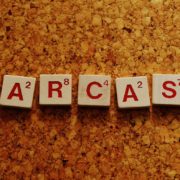What is flooding? What do I mean by a simple approach to ease flooding? And of course I am not talking about Katrina-type flooding, although the feeling is just as overwhelming as it was to the residents of New Orleans.

Flooding is that emotional feeling you get during a conflict when you feel like running out of the room and leaving your partner behind. You leap to the decision that the discussion was useless because , well, it is the same old circular mess. It happens on issues you get stuck in, and in fights where old hurts are dragged into the mix.
In nasty exchanges it is easy to feel overwhelmed and threatened; it is the feeling of being emotionally unsafe. If you can imagine a wild animal backed into the corner by a predator, with the fight, flight or freeze response triggered, you have the picture of what emotional flooding feels like. It is a state of insecurity and helplessness.
At this point, your interests narrow down to self preservation. Your heart rate goes up, and your ability to process incoming information with any credibility stops. And according to John Gottman’s research in The Science of Trust, in heterosexual relationships, men are more often flooded than women. Gottman also notes that contempt, a primary cause of flooding, is the number one predictor of divorce. This is when one partner assumes a one-up position over the other with a belief in their own superiority in almost any dimension.
Your physiology changes during flooding. As previously mentioned, your blood pressure increases, and if it exceeds approximately 100 beats/minute, (baseline rates differ according to physical health), the discussion will no longer be productive. In couples therapy, this can be detected using a simple pulse oximeter.
A Simple Approach to Ease Flooding
In order to address flooding, practice self soothing. This is done by stopping the discussion and taking a break. During the break, the partners should visually separate. The flooded partner must go and do an activity that is both distracting and relaxing. That might be any number of things including deep breathing, self-administered progressive relaxation, listening to music, reading a magazine, working at a task, or taking a walk around the neighborhood. However, the real point is that it must NOT be a break where you go into dress rehearsal for how you will take down the other upon resumption of the discussion. You are not plotting revenge or dwelling on thoughts like “How dare you”, or “How could you” or the ever popular “What is the matter with you?!?” That is a rhetorical question that is essentially an attack on the other’s character, and will never be happily answered by your partner, nor will it be productive for you.
And No, You May Not Have the Last Word!
All of this has to do with your ability to self regulate your emotions successfully. This can be really hard to achieve when you are both hurt and angry, hence the advised brief separation. And it is extremely important that when the flooded partner asks for a break, the other may not “get in the last word” before granting it. That is a guarantee for continuation down the toilet of nastiness. The partner that signals needing a break is to be granted the request immediately.
The break needs to last a minimum of 20 minutes because that is how along it takes for the limbic system to resume its normal setting to a calm state. The break is also not to be longer than 24 hours before the issue is readdressed. Otherwise it is simply avoidance of the issue.
It’s tough stuff, no doubt. But if you have arguments that are filled with tension and repetition, try this technique. If both of you want to solve the issue at hand, or at least come back to the table with a sense of calm, it is a skill worth learning.










